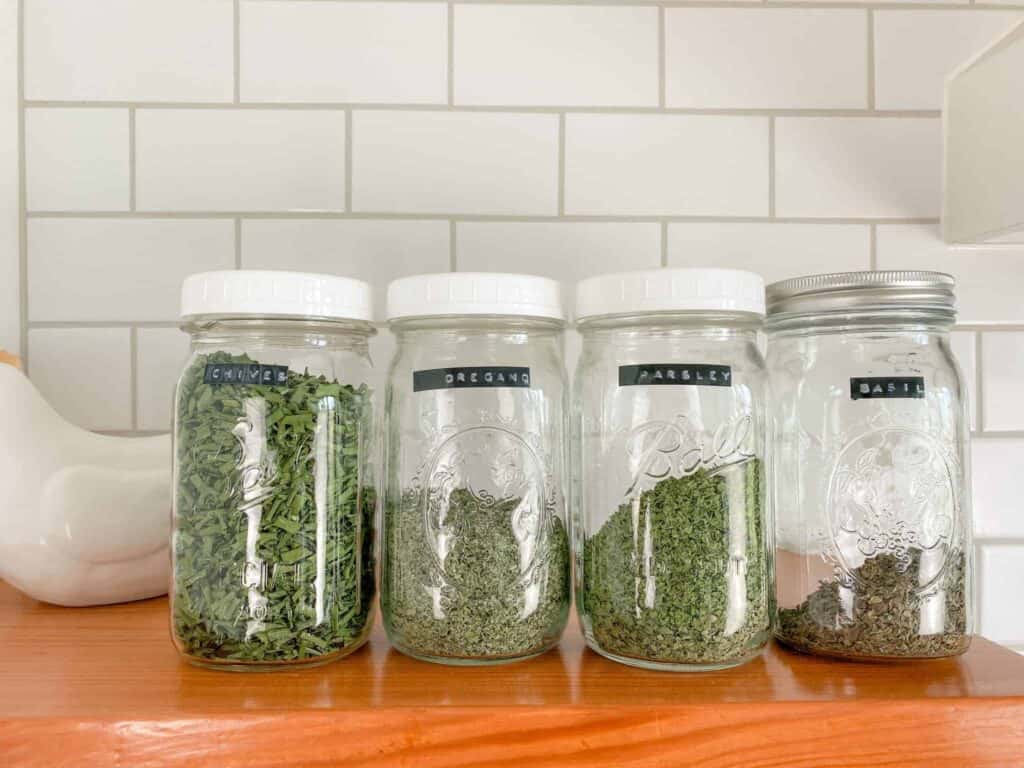SUMMARY: Drying herbs the right way keeps more of their nutrients, with best practices including correct temperature, timing, and storage methods. Using these methods makes sure dried herbs stay as nutritious as possible.
Are you wondering if your dried herbs retain all their valuable nutrients?

This concern is valid, especially when you’re aiming for both flavor and nutritional benefits in your cooking.
- The science behind nutrient loss in dried herbs
- The vital role of drying techniques
- Seven expert tips for nutrient retention
- Practical implementation of drying best practices
Continue reading to discover how you can maximize the nutritional value of your dried herbs with the right methods.
Understanding Nutrient Loss in Dried Herbs
When herbs are dried, they undergo a process that can potentially lead to the loss of nutrients. This phenomenon is influenced by factors such as the drying temperature, the length of time taken to dry, and the specific method used. While drying herbs serves to concentrate their flavors, it’s essential to recognize that some vitamins and volatile oils, responsible for both aroma and health benefits, can be sensitive to the drying process.
Herbs primarily lose water-soluble vitamins like vitamin C and B-vitamins during drying. The loss of these nutrients is primarily due to their sensitivity to air, light, and heat, all elements present during the drying process. However, the extent of this loss can vary significantly based on how the herbs are dried. The challenge and goal, then, are to use methods that minimize these losses, preserving as much of the herbs’ original nutritional value as possible.
Understanding this nutrient loss is crucial for optimizing the drying process and ensuring that the dried herbs you use are not only flavorful but also nutritionally beneficial. By acknowledging the factors that contribute to nutrient degradation, it becomes possible to adjust drying techniques accordingly, retaining more of those valuable vitamins and compounds.
The Importance of Proper Drying Techniques
Understanding and selecting the correct drying methods can significantly influence the degree of nutrient retention in dried herbs. The way herbs are dried plays a critical role in preserving their vitamins, minerals, and antioxidants. It is essential to differentiate between effective and ineffective drying techniques to maximize nutrient preservation.
Effective drying techniques such as air drying, dehydrating at low temperatures, or freeze drying aim to reduce the water content in herbs slowly and gently, thereby minimizing the loss of volatile compounds and sensitive nutrients. These methods ensure that the herbs retain their aroma, flavor, and most importantly, their nutritional value.
Conversely, exposing herbs to high temperatures or direct sunlight can lead to rapid degradation of essential oils and nutrients, including vitamins C and A, along with various antioxidants. Such conditions can also lead to the loss of flavor and medicinal properties. The importance of choosing the appropriate drying method cannot be overstated, as it directly affects the quality and health benefits of the final product.
In conclusion, adopting proper drying techniques is paramount for anyone looking to preserve the nutritional integrity of their herbs. By understanding the nuances of each method, one can ensure that their herbs are not only flavorful and aromatic but also packed with their natural, beneficial nutrients.
7 Best Practices for Retaining Nutrients in Dried Herbs
To preserve as much nutritional value as possible in dried herbs, certain practices can be followed. Implementing these strategies effectively can make a significant difference in maintaining the essential vitamins and minerals in your dried herbs.
- Opt for Air-Drying or Dehydrating: Whenever possible, use air-drying or a dehydrator set to a low temperature. These methods are gentle on the herbs and help in preserving their nutrients by minimizing heat exposure.
- Control the Temperature: High temperatures can destroy sensitive vitamins. When using a dehydrator, keep the temperature between 95°F to 115°F (35°C to 46°C) to best preserve the herbs’ nutritional content.
- Minimize Exposure to Light: Once dried, store herbs in a dark place. Light can degrade the nutrients quickly, so using dark glass containers or storing them in a pantry can protect their integrity.
- Keep Drying Times Short: Prolonged exposure to heat, even at low temperatures, can lead to nutrient loss. Monitor the drying process closely and remove herbs as soon as they’re dry to touch.
- Maintain Low Humidity: Humidity can prolong the drying process, increasing the risk of nutrient degradation. A low-humidity environment is essential for quick and effective drying.
- Use Fresh Herbs: The fresher the herbs, the higher their initial nutrient content. Begin the drying process as soon as possible after harvesting to lock in vitamins and minerals.
- Proper Storage: After drying, herbs should be stored in airtight containers to prevent moisture from getting in, which can lead to mold growth and further nutrient loss. Labeling containers with the date of drying can also help you use older stock first and keep your rotation fresh.
By adopting these seven practices, you can significantly enhance the nutritional retention of your dried herbs, ensuring that they remain a healthy addition to your meals.
Implementing Best Practices in Your Kitchen
Putting into practice the best strategies for retaining nutrients in dried herbs is easier than you might think. Here are actionable steps to integrate these practices into your kitchen routine, ensuring maximum nutrient retention in your home-dried herbs.
- Plan Your Drying Process: Identify the best time to harvest your herbs, aiming for when they are most vibrant and before they flower for optimal nutrient content. Schedule drying when you can devote time to monitor the process, ensuring herbs aren’t exposed to heat or light for too long.
- Choose the Right Equipment: Invest in a good quality dehydrator if you frequently dry herbs. This can give you greater control over temperature and ensure a consistent drying environment. For air-drying, ensure you have ample space in a dark, well-ventilated area.
- Monitor Humidity: Use a hygrometer to check the humidity levels of your drying area. If humidity is too high, consider using a dehumidifier or choosing a different location to avoid prolonging drying times and risking nutrient degradation.
- Prepare Herbs Correctly: Wash and dry your herbs thoroughly but gently before drying to remove any dirt or bacteria without damaging the leaves. This ensures a clean product and helps in preventing mold growth during the drying process.
- Store Properly: Once dried, transfer your herbs to airtight containers immediately to avoid exposure to air and light. If possible, vacuum seal bags to extend shelf life and maintain nutrient content. Remember to label everything clearly with the herb type and date of drying.
- Regularly Check Your Stock: Make it a habit to inspect your stored herbs periodically for signs of moisture or spoilage, and use older stocks first to maintain a fresh, nutritious supply.
Integrating these best practices into your kitchen activities doesn’t just help in preserving the nutritional value of your dried herbs; it also enhances the flavor and quality of your cooking, making your efforts well worth it.
Best Practices for Drying and Storing Herbs
In this comprehensive guide, we’ve uncovered the essential strategies for preserving the nutritional integrity of dried herbs.
- Understanding nutrient loss is crucial for preserving the health benefits of dried herbs.
- Proper drying techniques play a pivotal role in nutrient retention.
- Implementing the seven best practices can significantly minimize nutrient loss during the drying process.
- Simple adjustments in how you dry, store, and handle herbs can make a substantial difference in their nutritional value.
- Applying these practices in your kitchen will help maintain the potency and benefits of your dried herbs.
By embracing these techniques, you’ll ensure that your dried herbs remain not only flavorful but also nutritionally beneficial, supporting your health and enriching your culinary creations.
7 Best Ways to Retain Nutrients in Dried Herbs FAQs
Do all herbs lose the same amount of nutrients when dried?
The amount of nutrients lost during the drying process varies among different types of herbs. Factors such as the herb’s moisture content, density, and the method used for drying can affect the rate of nutrient loss. For instance, delicate herbs like basil may lose nutrients more quickly than hardier herbs like rosemary.
Can the loss of nutrients be completely prevented?
While it’s challenging to completely prevent the loss of nutrients when drying herbs, the goal is to minimize this loss as much as possible. By adhering to best practices such as proper drying techniques, temperature control, and appropriate storage, you can significantly reduce nutrient degradation and maintain the health benefits of your herbs.
How long can you store dried herbs without significant nutrient loss?
Dried herbs can generally be stored for up to a year without significant nutrient loss, provided they are kept in an airtight container and stored in a cool, dark, and dry place. However, for optimal nutrient retention and flavor, it is recommended to use dried herbs within six months of drying. Rotating your stock and properly labeling your dried herbs with drying dates will help ensure you’re using them within this optimal timeframe.
What is the best method to dry herbs to retain their nutrients?
The best method to dry herbs while retaining their nutrients is by using a dehydrator set to a low temperature, as this minimizes the loss of heat-sensitive vitamins. Air drying in a well-ventilated, dark, and dry area is also effective, especially for herbs that do not have high moisture content. These methods help preserve the herbs’ essential oils, which are responsible for their flavor and many of their health benefits, while minimizing nutrient loss.
